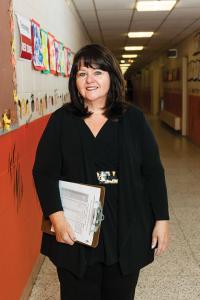
From the time she was in first grade, Susan Weinman imagined herself a teacher. After 17 years as a teacher in Virginia and New Jersey, she became principal of Thomas Paine Elementary School in the Cherry Hill, N.J., Township School District. She held that position for 12 years. Weinman’s colleagues on the district’s Cultural Proficiency Committee nominated her for Down the Hall because of her ability to see the whole child and her commitment to meeting the needs of all students.
What inspired you to pursue a career in education?
Whether teaching or acting in some administrative position, I have always appreciated being surrounded by the innocence and imagination of kids and the dedication of adults who love them.
Have you always wanted to be an administrator?
Not at all. I was enjoying my job as a computer teacher when my principal, Steve Cochrane, encouraged me to take a job as a helping teacher in his school. He began mentoring me into administration. My path to administration made me realize the importance of mentoring others.
Your colleagues say that you are masterful at looking at the whole child. Why is that important?
We have to realize that a child coming to school carries with her the sum of her life—good and bad—gifts, talents, struggles, needs, family strengths and issues, culture and economic status. In order for that student to be socially, emotionally and academically successful, we have to know and value who she is and what she is experiencing in life. The same is true for teachers. Valuing each person’s authentic life experiences is important in developing a caring and supportive educational environment where people can be at their best.
How do you define success for students?
Success, for students, means continuous growth on a path of social, emotional and academic self-awareness and achievement. Even in this age of accountability to academic standards, every child needs to be instructed in a way that makes those standards accessible regardless of the obstacles they may face.
How do you help teachers successfully meet the needs of all learners?
In the last 10 years, our school’s demographics have changed significantly. Our students speak about 25 different languages. About 42 percent are students of color, and a third receive free or reduced-price lunch. The academic rigor is constantly increasing. My job is to help teachers identify the needs in our school and find professional development that appropriately addresses those needs. Research clearly shows that when teachers come together to study the needs of students and plan appropriate instruction and intervention, achievement improves. I commend Cherry Hill for allowing 30 minutes each morning for professional learning community activities.
Why did you take a leadership role in the Cultural Proficiency Committee?
I realized we will never close achievement gaps and meet the needs of our students if we can’t create a truly inclusive environment in which diversity is valued and respected. To support our students, we had to get over our “color blindness,” recognize the differences and understand the impact they have on student growth and development. Many educators were taught to treat everyone identically. Sometimes they see differences, but treat them as if they are insignificant in the children’s lives. These educators might assume that the values and behaviors of the dominant culture are universally applicable and equally beneficial to all. That assumption dismisses a huge part of who children of color are, what they value and how they learn—and it can leave many children and their families feeling discounted or invisible.
What books on social justice would you recommend to educators?
Why Are All the Black Kids Sitting Together in the Cafeteria: And Other Conversations About Race by Beverly Daniel Tatum taught me about the significance of racial identity. Uprooting Racism: How White People Can Work for Racial Justice by Paul Kivel and Courageous Conversations About Race: A Field Guide for Achieving Equity in Schools by Glen Singleton and Curtis Linton deepened my understanding of the issues around race in the United States.
Susan Weinman, now retired, was the principal at Thomas Paine Elementary School in Cherry Hill, N.J.
Know an excellent administrator, librarian or counselor we should interview?
Tell us all about them.